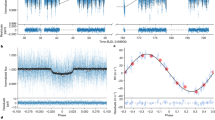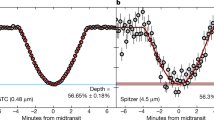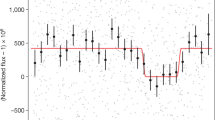Abstract
Pluto and Eris are icy dwarf planets with nearly identical sizes, comparable densities and similar surface compositions as revealed by spectroscopic studies1,2. Pluto possesses an atmosphere whereas Eris does not; the difference probably arises from their differing distances from the Sun, and explains their different albedos3. Makemake is another icy dwarf planet with a spectrum similar to Eris and Pluto4, and is currently at a distance to the Sun intermediate between the two. Although Makemake’s size (1,420 ± 60 km) and albedo are roughly known5,6, there has been no constraint on its density and there were expectations that it could have a Pluto-like atmosphere4,7,8. Here we report the results from a stellar occultation by Makemake on 2011 April 23. Our preferred solution that fits the occultation chords corresponds to a body with projected axes of 1,430 ± 9 km (1σ) and 1,502 ± 45 km, implying a V-band geometric albedo pV = 0.77 ± 0.03. This albedo is larger than that of Pluto, but smaller than that of Eris. The disappearances and reappearances of the star were abrupt, showing that Makemake has no global Pluto-like atmosphere at an upper limit of 4–12 nanobar (1σ) for the surface pressure, although a localized atmosphere is possible. A density of 1.7 ± 0.3 g cm−3 is inferred from the data.
This is a preview of subscription content, access via your institution
Access options
Subscribe to this journal
Receive 51 print issues and online access
$199.00 per year
only $3.90 per issue
Buy this article
- Purchase on Springer Link
- Instant access to full article PDF
Prices may be subject to local taxes which are calculated during checkout



Similar content being viewed by others
References
Licandro, J. et al. Visible spectroscopy of 2003 UB313: evidence for N2 ice on the surface of the largest TNO? Astron. Astrophys. 458, L5–L8 (2006)
Tegler, S. C. et al. Ice mineralogy across and into the surfaces of Pluto, Triton, and Eris. Astrophys. J. 751, 76 (2012)
Sicardy, B. et al. A Pluto-like radius and a high albedo for the dwarf planet Eris from an occultation. Nature 478, 493–496 (2011)
Licandro, J. et al. The methane ice rich surface of large TNO 2005 FY9: a Pluto-twin in the trans-Neptunian belt? Astron. Astrophys. 445, L35–L38 (2006)
Stansberry, J. A. et al. in The Solar System Beyond Neptune. 161–179 (eds Barucci, M. A., Boehnhardt, H., Cruikshank, D. P., Morbidelli, A. & Dotson, R. ) (Univ. Arizona Press, 2008)
Lim, T. et al. “TNOs are Cool”: A survey of the trans-Neptunian region. III. Thermophysical properties of (90482) Orcus and (136472) Makemake. Astron. Astrophys. 518, L148 (2010)
Stern, S. A. & Trafton, L. M. in The Solar System Beyond Neptune (eds Barucci, M. A., Boehnhardt, H., Cruikshank, D. P., Morbidelli, A. & Dotson, R. ) 365–380 (Univ. Arizona Press, 2008)
Schaller, E. L. & Brown, M. E. Volatile loss and retention on Kuiper belt objects. Astron. J. 659, L61–L64 (2007)
Hubbard, W. B., Hunten, D. M., Dieters, S. W., Hill, K. M. & Watson, R. D. Occultation evidence for an atmosphere on Pluto. Nature 336, 452–454 (1988)
Young, E. F. et al. Vertical structure in Pluto's atmosphere from the 2006 June 12 stellar occultation. Astron. J. 136, 1757–1769 (2008)
Sicardy, B. et al. Charon's size and an upper limit on its atmosphere from a stellar occultation. Nature 439, 52–54 (2006)
Elliot, J. L. et al. Size and albedo of Kuiper belt object 55636 from a stellar occultation. Nature 465, 897–900 (2010)
Assafin, M. et al. Candidate stellar occultations by large trans-Neptunian objects up to 2015. Astron. Astrophys. 541, A142 (2012)
Moorwood, A. et al. ISAAC at the VLT. Messenger 95, 1–5 (1999)
Stetson, P. B. DAOPHOT — a computer program for crowded-field stellar photometry. Publ. Astron. Soc. Pacif. 99, 191–222 (1987)
Brown, M. E. et al. Satellites of the largest Kuiper belt objects. Astrophys. J. 639, L43–L46 (2006)
Rabinowitz, D. L., Schaefer, B. E. & Tourtellotte, S. W. The diverse solar phase curves of distant icy bodies. I. Photometric observations of 18 trans-Neptunian objects, 7 centaurs, and Nereid. Astron. J. 133, 26–43 (2007)
Buratti, B. et al. Photometry of Pluto in the last decade and before: evidence for volatile transport? Icarus 162, 171–182 (2003)
Rabinowitz, D. et al. Photometric observations constraining the size, shape, and albedo of 2003 EL61, a rapidly rotating, Pluto-sized object in the Kuiper belt. Astrophys. J. 639, 1238–1251 (2006)
Heinze, A. N. & de Lahunta, D. The rotation period and light-curve amplitude of Kuiper belt dwarf planet 136472 Makemake (2005 FY9). Astron. J. 138, 428–438 (2009)
Thirouin, A. et al. Short-term variability of a sample of 29 trans-Neptunian objects and centaurs. Astron. Astrophys. 522, A93 (2010)
Tancredi, G. & Favre, S. Which are the dwarfs in the Solar System? Icarus 195, 851–862 (2008)
Müller, T. et al. Makemake: A truly exotic TNO!. EPSC-DPS Joint Meeting, Nantes, France 1416 (2011)
Ortiz, J. et al. Short-term rotational variability in the large TNO 2005 FY9 . Astron. Astrophys. 468, L13–L16 (2007)
Fray, N. & Schmitt, B. Sublimation of ices of astrophysical interest: a bibliographic review. Planet. Space Sci. 57, 2053–2080 (2009)
Alvarez-Candal, A. et al. The spectrum of (136199) Eris between 350 and 2350 nm: results with X-Shooter. Astron. Astrophys. 532, A130 (2011)
Elliot, J. L. et al. Occultation of Epsilon Geminorum by Mars. II — The structure and extinction of the Martian upper atmosphere. Astrophys. J. 217, 661–679 (1977)
Acknowledgements
These results were based partially on observations made with European Southern Observatory Telescopes at the La Silla and Paranal Observatories under programme 287C-5013. J.L.O. acknowledges funding from Spanish and Andalusian grants and the European Regional Development Fund (FEDER). B.S. acknowledges support from French National Research Agency (ANR) grant ‘Beyond Neptune’, and from the Institut Universitaire de France. E.U.-S. acknowledges the support from the Chilean National Commission for Scientific and Technical Research (Gemini-CONICYT funds), and from the North Catholic University of Chile Vicerectorate of Research and Technology Development (UCN-VRIDT). TRAPPIST is a project funded by the Belgian Fund for Scientific Research (FRS-FNRS) with the participation of the Swiss National Science Foundation (SNF). J.I.B.C. acknowledges grants by the Brazilian National Council for the Development of Science and Technology (CNPq), and the Foundation for Research Support of the State of Rio de Janeiro (FAPERJ). P.S.-S. acknowledges financial support by the Centre National de la Recherche Scientifique (CNRS). R.G.-H. acknowledges partial financial support by the Argentinian National Scientific and Technical Research Council (CONICET). F.B.-R. acknowledges the support of the French-Brazilian Doctoral College Coordination of Improvement of Graduated Personnel programme (CDFB/CAPES). A.A.-C. acknowledges support from the Marie Curie Actions of the European Commission (FP7-COFUND). S.P.L., V.S.D. and T.R.M. acknowledge funding for ULTRACAM from the UK Science and Technology Facilities Council. R.D. acknowledges support from Spanish Ministry of Economics and Competitiveness through a Ramón y Cajal contract.
Author information
Authors and Affiliations
Contributions
J.L.O. helped to plan the campaign, analysed data for the prediction, made the prediction, participated in the observations, obtained and analysed data, interpreted data and wrote part of the paper. B.S. helped to plan the campaign, participated in the observations, analysed data, interpreted data, wrote and ran the diffraction and ray-tracing codes and wrote part of the paper. F.B.-R. and A.A.-C. helped to plan the campaign, participated in the observations and analysed and interpreted data. E.L. analysed the implications of the results for Makemake’s thermal model and putative atmospheric structure and wrote part of the paper. R.D. and V.D.I. helped to plan the observations and analysed data. J.I.B.C., S.P.L., E.U.-S., J.P.C., E.J. and J.M. participated in the observations and analysed data. M.A., F.B.-R., J.I.B.C., R.V.-M., D.N.d.S.N. and R.B. discovered the star candidate and analysed data. P.J.G. and T.M. made thermal models and participated in the interpretation. All other authors participated in the planning of the campaign and/or the observations and/or the interpretations. All authors were given the opportunity to review the results and comment on the manuscript.
Corresponding author
Ethics declarations
Competing interests
The authors declare no competing financial interests.
Supplementary information
Supplementary Information
This file contains Supplementary Text and Data 1-8, Supplementary Figures 1-7, Supplementary Table 1 and additional references. (PDF 1017 kb)
Rights and permissions
About this article
Cite this article
Ortiz, J., Sicardy, B., Braga-Ribas, F. et al. Albedo and atmospheric constraints of dwarf planet Makemake from a stellar occultation. Nature 491, 566–569 (2012). https://doi.org/10.1038/nature11597
Received:
Accepted:
Published:
Issue Date:
DOI: https://doi.org/10.1038/nature11597
Comments
By submitting a comment you agree to abide by our Terms and Community Guidelines. If you find something abusive or that does not comply with our terms or guidelines please flag it as inappropriate.



